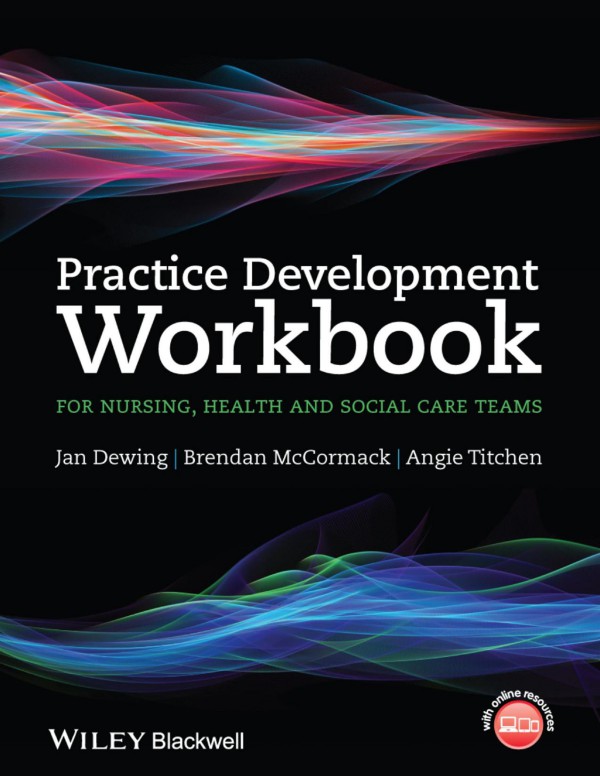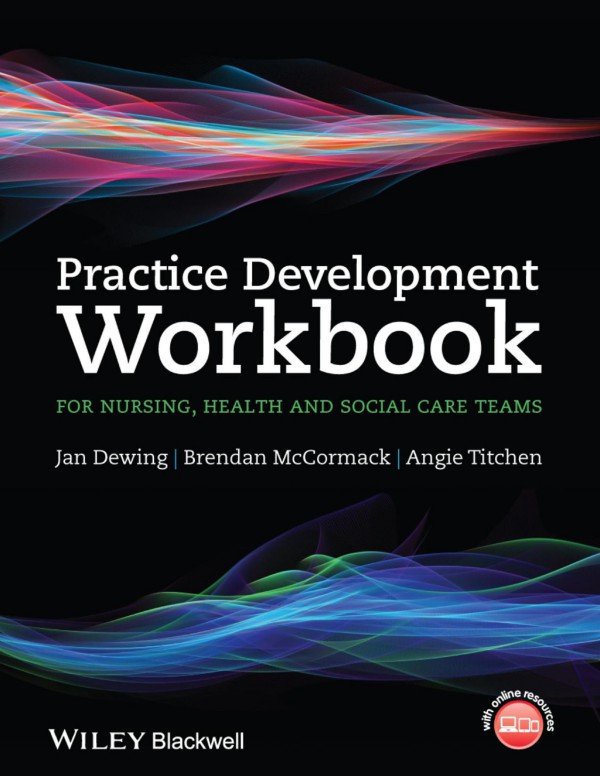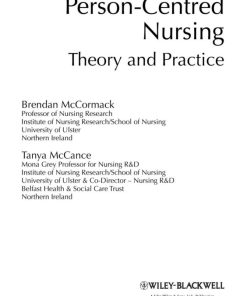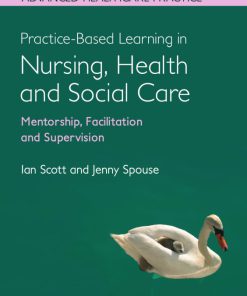Practice Development Workbook for Nursing Health and Social Care Teams 1st Edition by Jan Dewing, Brendan McCormack, Angie Titchen 111867670X 9781118676707
$50.00 Original price was: $50.00.$25.00Current price is: $25.00.
Authors:Titchen, Angie, McCormack, Brendan, Dewing, Jan , Author sort:Titchen, Angie, McCormack, Brendan, Dewing, Jan , Published:Published:Mar 2014
Practice Development Workbook for Nursing Health and Social Care Teams 1st Edition by Jan Dewing, Brendan McCormack, Angie Titchen – Ebook PDF Instant Download/Delivery. 111867670X, 9781118676707
Full download Practice Development Workbook for Nursing Health and Social Care Teams 1st Edition after payment

Product details:
ISBN 10: 111867670X
ISBN 13: 9781118676707
Author: Jan Dewing, Brendan McCormack, Angie Titchen
If you’re looking to develop and improve your nursing, health or social care practice, either individually or as part of a team, the Practice Development Workbook for Nursing, Health and Social Care Teams offers a wide-ranging selection of activities, tools and resources covering vital aspects of practice development. Written as a companion volume to the latest edition of the best-selling Practice Development in Nursing and Healthcare, this new resource grounds practice development in day-to-day nursing and health and social care through accessible, informative learning activities. It also focuses on practical ways in which teams can make their workplace cultures more effective and person-centred, and enables practitioners to empower themselves to make compassionate care a fundamental part of effective health and social care systems.
Key features:
- Offers a full range of resources and tools to support all stages of learning and development towards person-centred practice, including learning activities, templates, posters, tips and hints, information sheets, and checklists.
- Includes practical advice for teams to involve patients, clients and residents in the transformation of workplace cultures and bringing about sustainable change
- Perfect for use both by individuals or by those working in group settings
- Presents informative and accessible information through activities and key learning points rather than just theory
- Fully linked to Practice Development in Nursing and Healthcare, second edition, but can also be used as a stand-alone resource
- Includes access to a companion website featuring even more tools and resources, including: sample Powerpoint presentations, worksheets and reflection tools, questionnaires and checklists, evaluation tools, as well as a bonus chapter on ‘Sharing and Celebrating’
Practice Development Workbook for Nursing Health and Social Care Teams 1st Table of contents:
Chapter 1 Introduction: Getting the Best Out of This Resource
Contents
Introduction
Aim of the resource
This resource matters because . . .
Compliance
Quality
Who is it for?
Why use this resource?
How can this resource be used in your workplace?
Fig. 1.1 The key steps of the practice development journey.
What is practice development?
Fig. 1.2 Practice development (adapted from Garbett & McCormack, 2002).
The principles of practice development work
The person-centred practice framework
Fig. 1.3 The person-centred practice framework (McCormack & McCance, 2010).
Useful websites and resources (also see Chapters 3, 5, 8, 10 & bonus online chapter and for Frequently Asked Questions, see Chapter 9)
Chapter 2 Knowing and Demonstrating Values and Beliefs about Person-Centred Care
Contents
Introduction
Fig. 2.1 A step on the practice development journey: Knowing and demonstrating values and beliefs.
Plough the furrow and plant the seed at the same time
Resources in this chapter
Reflection on my own values and beliefs about the care/service I give or receive
Key activities
An alternative way of doing this activity
You can also do these activities with a learning buddy/supervisor
Going for a reflective walk on your own or with someone else
Key activities
Values and beliefs of the care setting
Key activities
Fig. 2.2 Making a poster or collage.
Leaders’ values and beliefs
Key activities
Sheet 2.1: Worksheet for recording learning activities with a buddy: Values and beliefs about . . . . . . . . . . . . care
Sheet 2.2: Discussion groups
Key activities
Discussion trigger 2.1: Short videos
Patient Stories
Patients’ Experiences
Institute for Healthcare Improvement Hear our voice: collecting patient experience stories
Patient Voices: digital stories
What do you see? film – YouTube
Social Care Institute for Excellence (SCIE)
My home life
Dying Matters
Hospice Friendly Hospitals
Sheet 2.3: Handout: How to feature values and beliefs in your work around the care setting/care home
Setting a no blame climate
Showing how values and beliefs are influencing care and service in your setting/home
Quick evaluation
Celebrating a match between actual and person-centred values
Sheet 2.4: Values and beliefs template (Warfield & Manley 1990)
Sheet 2.5: Values and beliefs clarification activity: A facilitator’s guide
Principles and things that you need to have before you start
Fig. 2.3 Flipcharts with statements and coloured sticky notes.
The invitations: Setting out the purpose
Instruction sheet
Theming the statements
Sharing the themes and drafting summary statements
Putting values and beliefs into practice
Sheet 2.6: Instruction sheet for patients/residents, families and care staff for the values and beliefs clarification activity
Chapter 3 Developing a Shared Vision for Person-Centred Care
Contents
Introduction
Fig. 3.1 The next step on the practice development journey: Developing a shared vision.
What is a shared vision?
Resources in this chapter
Guide: Setting up a practice development coordinating group for visioning activities
Sheet 3.1: Templates for group meeting agendas and notes
Sheet 3.2: Group relaxation activity
Sheet 3.3: Creative methods for developing a shared vision: Programme of three workshops (you decide which one you might do)
Visualisation through painting and/or collage
Visioning
Vision statement development
Sheet 3.4: Workshop guidance: Visualisation through painting and/or collage
Key activities
Fig. 3.2 An example of using painting and collage in practice development work.
Sheet 3.5: Workshop guidance: Creating and sharing personal visions
Examples
Sheet 3.6: Workshop guidance: Vision statement development
Sheet 3.7: Guide: Visioning with a virtual group
Example
Sheet 3.8: Questionnaire: Developing a shared vision for person-centred care at
Sheet 3.9: Visioning the practice development processes and developing ground rules (one-to-one)
Key activities
Example of ground rules
Sheet 3.10: Visioning the practice development processes and developing ground rules (small informal group)
Key activities
Example of ground rules
Sheet 3.11: Workshop guidance: Visioning the practice development processes and developing ground rules
Sheet 3.12: What do we do next?
Useful websites and resources
Chapter 4 Introduction to Measuring Progress and Evaluation
Contents
Introduction: Why measuring and evaluating is important
Fig. 4.1 The next step on the practice development journey: Introduction to measuring progress and evaluation.
Resources in this chapter
Workshop guidance: Current evaluation methods within your organisation
Key activities
Trigger for group discussion: What are ‘metrics’ and how do we measure person-centred care?
Trigger for group discussion: Practice development principles for measuring and evaluation
Learning activity for teams: Evaluating care plans
Key activities
Example 1
Example 2
Learning activity for teams: Evaluating your respect for dignity, privacy and the control people have in your service
Key activities
Learning activity for teams: Cats, skirts, handbags and lipstick
Key activities
Learning activity for staff who serve food & drink: Evaluating the service you offer
Example 1
Example 2
Learning activity for housekeepers: Evaluating the cleaning, housekeeping or repair service you offer
Key activities
Example 1
Example 2
Learning activity for team or home managers and those with an interest in learning and practice development: Evaluating the learning support systems for care teams
Key activities
Guide: Reflection tools
What is reflection?
Why should I do it then?
How do I do it?
What will I get out of it?
What is in it for people for whom I provide care/services?
Getting the commitment of stakeholders
Key activities
Template for developing a communication plan with stakeholders
Guide: Setting up and sustaining a practice development coordinating group1
Claims, Concerns and Issues: An evaluation tool for working with stakeholders (Guba & Lincoln, 1989)
A template for stakeholders’ views: Claims, Concerns and Issues
An example of Claims, Concerns and Issues (1)
An example of Claims, Concerns and Issues (2)
Guide: Facilitating Claims, Concerns and Issues (adapted from Dewing & Titchen, 2007)
Option A
Option B
Option C
Chapter 5 Getting Started Together: Measuring and Evaluating Where We Are Now
Contents
Introduction
Fig. 5.1 The next step: Measuring and evaluating where we are now.
Resources in this chapter
Guidance on developing evaluation questions
SWOT or TOWS tool
Forcefield analysis
Gathering evidence in the workplace
Giving and receiving feedback after evidence has been gathered
Giving and receiving feedback
Feedback is not criticism
Principles for giving and receiving feedback
Workplace observations: Walkabout guide
Preparation
Key activities
Workplace observations: In a fixed place
Workplace observations: Record sheet
Combined observations: Record sheet for feedback
Guide: Observations of care
Guide: Patient/resident/relative narrative interview
Preparation for you
Preparation for the patient/resident/relative/friend
Guide: Conversation with patients/residents with severe cognitive impairment
Team culture tool (Pritchard & Dewing, 2000)
Making sense of the results
Handout: Culture (Bate, 1995)
Handout: Effective workplace culture (Manley et al. 2011)
Useful websites and resources
Chapter 6 A Practice Development Plan
Contents
Introduction
Fig. 6.1 The next step: A practice development plan for integrated action, learning and evaluation.
Fig. 6.2 Inviting people to paint what matters to them about the shared journey to be undertaken can free people up for action planning.
Resources in this chapter
Pulling it together activity 1: Individual/informal group activity for analysis of evidence (in preparation for action planning)
Individual activity
Small and informal group activity
Option 1
Option 2
Both options
Pulling it together workshop 1: Analysis of evidence gathered through observations, narratives and conversations (after Boomer & McCormack, 2008; McCormack et al., 2010)
Process used for analysis of narrative, conversations and observation evidence
Pulling it together workshop 2: Comparing findings and interpretations
Fig. 6.3 Example of a poster made in a workshop.
Key activities
Pulling it together activity 2: Individual/informal group activity for identifying indicators to prioritise action planning
Individual activity
Key activities
Small informal group activity
Key activities
Pulling it together workshop 3: Identifying indicators and using them to prioritise action planning
Key activities
Practice development coordinating group: Roles and responsibilities
Person-centred practice templates
Evidence summary and action plan for aims and goals based on the person-centred practice framework (McCormack & McCance, 2010)
Overview action planning guide
SMART and SMARTER goals
Chapter 7 Mini-projects: Ongoing and Integrated Action, Evaluation, Learning and Planning
Contents
Introduction
Fig. 7.1 The next step: Mini-projects and ongoing, integrated action, evaluation, learning and planning.
Fig. 7.2 The parts mirror the whole structure.
Resources in this chapter
Examples of mini-projects
1. ‘Light bulb moment’
2. Inconsistency and contradictions
3. Older Persons National Practice Development Programme in the Republic of Ireland (2007–2009) (McCormack et al., 2010)
Mini-projects: Guide to structure and processes
Mini-project group structure
Mini-projects: Roles and responsibilities
Developing, implementing and evaluating the mini-project plan
Mini-projects: Work organisation / ways of working
Things to think about when inviting people to join the mini-project group
Once the group is established, group members will need to:
Fig. 7.3 The structure at Sunnyside Care Home, South of England.
Mini-project processes
Group processes
Action planning
Sheet 7.1: Leading a project/working/action or learning group
Sheet 7.2: Mini-project action planning template
Sheet 7.3: Example: Filled in mini-project action planning template
What do you do with this next?
Chapter 8 Learning in the Workplace
Contents
Introduction
Fig. 8.1 The next step: Learning in the workplace.
Fig. 8.2 Just as spirals are found all around us in nature, facilitation and learning are often depicted by practice developers as spirals.
Resources in this chapter
Part 1: Creating a person-centred learning environment
Part 2: Active learning
Part 3: Learning supervision
PART 1: Creating a person-centred learning environment (culture and infrastructure that supports learning)
Sheet 8.1: A learning culture guide
Art for their sake
She without arm, he without leg
Where the hell is Matt?
Personalisation for older people: Residential care
Commentary
Information-giving
Collaboration, Inclusion and Participation (CIP)
Sheet 8.2: Activity and guidance for managers for creating a person-centred learning environment
Guidance
Example 1
Example 2
Sheet 8.3: Evaluation and process review of group work and sessions
Quick evaluation
Process review
Sheet 8.4: Giving and receiving feedback handout
Example
Giving and receiving feedback
Activity
The purpose of feedback
Giving feedback: What works
Giving feedback: What doesn’t work
Receiving feedback: What works
Structured feedback
PART 2: Active learning
Enabling questions
Activity 8.1: The 15 minute reflection space
Activity 8.2: Practising the use of open enabling questions in active learning
Key activities
Presenter
Enabler
Observer
Sheet 8.5: Preparation for activities 3–6
Key activities
Activity 8.3: Reflection on ‘self as active learner’
Activity 8.5: Positive incident accounts
Sheet 8.6: Worksheet for recording learning and action points
Sheet 8.7: Process evaluation: Listening critically to other peoples’ work
Sheet 8.8: Process evaluation record: Listening skills
Sheet 8.9: Process evaluation record: What I said
Sheet 8.10: Active learning evaluation
PART 3: Learning supervision
Induction programmes, preceptorship, mentorship, coaching and work-based learning facilitation
Induction and preceptorship programmes
Supporting staff
Mentorship
Coaching
Work-based learning facilitation
Clinical or professional supervision for the future
Summary of learning in the workplace
Useful websites
Chapter 9 What If . . .? When Things Don’t Go So Well
Contents
Introduction
Fig. 9.1 When things don’t go so well
Resources in this chapter
Frequently asked questions
Most common challenges
1. Heavy workloads
2. Working in care settings with older people (especially those with dementia) is hard work
3. Doing practice development in times of major financial pressure and economic cut-backs
4. Lack of management support
5. Making practice changes is not easy
6. Scepticism about patients/residents being able to contribute to practice development
7. Initial difficulty in working with the principles of Collaboration, Inclusion and Participation (CIP)
Identifying why things are not going well
Checklist
Sheet 9.1: Material from other chapters in this resource that can be used for addressing things that don’t go well
Activity 9.1: Acknowledging our own part in what didn’t go well
Key activities
Activity 9.2: Helping each other learn from what didn’t go well and work out what to do about it
Option 1: Working in threes (presenter, helper and observer)
Key activities
Presenter
Helper
Observer
Option 2: After Action Review (AAR)
The After Action Review (AAR) Toolkit
What is an AAR?
Why would you conduct an AAR?
Who participates in an AAR?
When do you conduct an AAR?
How long should an AAR take?
How do you conduct an AAR?
The After Action Review (AAR) Toolkit
Activity 9.3: Acknowledging, in the working day, when things don’t go well and affirming plans to change
Key activities
Chapter 10 Practice Development as a Continuous Process
Contents
Introduction
Fig. 10.1 Practice development as a continuous process
Resources in this chapter
Activity 10.1: Look after yourself and your health
Change 4 Life
Activity 10.2: Keeping it fresh everyday
Key activities
Postscript
Guidance: Keeping practice development fresh
Examples: The art of re-invention
Examples of re-inventing practice development
Activity 10.3: The art of re-invention
Option 1: Reflection activity
Option 2: The ‘re-invention game’
Key activities
Option 3: Naming activity
Linking to new policy agendas
Useful websites and resources
People also search for Practice Development Workbook for Nursing Health and Social Care Teams 1st:
early childhood development worksheets
t practice worksheet
practice workbook 2b-2
practice workbook 1b-5












